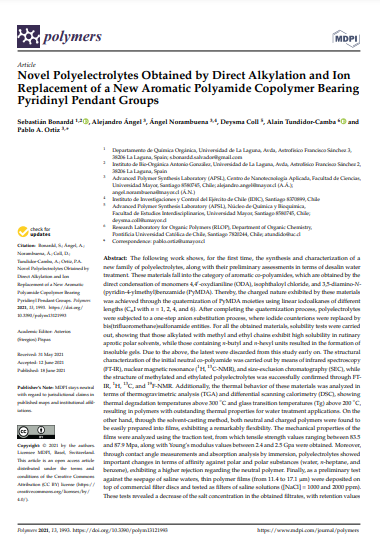Novel Polyelectrolytes Obtained by Direct Alkylation and Ion Replacement of a New Aromatic Polyamide Copolymer Bearing Pyridinyl Pendant Groups

Fecha
2021-07-05Autor
Bonardd, Sebastian
Coll, Deysma
Tundidor-Camba, Alain
Angel, Alejandro [Univ Mayor, Fac Ciencias, Ctr Nanotecnol Aplicada, Adv Polymer Synth Lab APSL, Chile]
Norambuena, Angel [Univ Mayor, Fac Ciencias, Ctr Nanotecnol Aplicada, Adv Polymer Synth Lab APSL, Chile]
Ortiz, Pablo A. [Univ Mayor, Fac Ciencias, Ctr Nanotecnol Aplicada, Adv Polymer Synth Lab APSL, Chile]
Ubicación geográfica
Notas
HERRAMIENTAS
Acceda a títulos restringidos
¿Cómo descargar?Resumen
The following work shows, for the first time, the synthesis and characterization of a new family of polyelectrolytes, along with their preliminary assessments in terms of desalin water treatment. These materials fall into the category of aromatic co-polyamides, which are obtained by the direct condensation of monomers 4,4 '-oxydianiline (ODA), isophthaloyl chloride, and 3,5-diamino-N-(pyridin-4-ylmethyl)benzamide (PyMDA). Thereby, the charged nature exhibited by these materials was achieved through the quaternization of PyMDA moieties using linear iodoalkanes of different lengths (CnI with n = 1, 2, 4, and 6). After completing the quaternization process, polyelectrolytes were subjected to a one-step anion substitution process, where iodide counterions were replaced by bis(trifluoromethane)sulfonamide entities. For all the obtained materials, solubility tests were carried out, showing that those alkylated with methyl and ethyl chains exhibit high solubility in rutinary aprotic polar solvents, while those containing n-butyl and n-hexyl units resulted in the formation of insoluble gels. Due to the above, the latest were discarded from this study early on. The structural characterization of the initial neutral co-polyamide was carried out by means of infrared spectroscopy (FT-IR), nuclear magnetic resonance (H-1, C-13-NMR), and size-exclusion chromatography (SEC), while the structure of methylated and ethylated polyelectrolytes was successfully confirmed through FT-IR, H-1, C-13, and F-19-NMR. Additionally, the thermal behavior of these materials was analyzed in terms of thermogravimetric analysis (TGA) and differential scanning calorimetry (DSC), showing thermal degradation temperatures above 300 degrees C and glass transition temperatures (Tg) above 200 degrees C, resulting in polymers with outstanding thermal properties for water treatment applications. On the other hand, through the solvent-casting method, both neutral and charged polymers were found to be easily prepared into films, exhibiting a remarkably flexibility. The mechanical properties of the films were analyzed using the traction test, from which tensile strength values ranging between 83.5 and 87.9 Mpa, along with Young's modulus values between 2.4 and 2.5 Gpa were obtained. Moreover, through contact angle measurements and absorption analysis by immersion, polyelectrolytes showed important changes in terms of affinity against polar and polar substances (water, n-heptane, and benzene), exhibiting a higher rejection regarding the neutral polymer. Finally, as a preliminary test against the seepage of saline waters, thin polymer films (from 11.4 to 17.1 mu m) were deposited on top of commercial filter discs and tested as filters of saline solutions ([NaCl] = 1000 and 2000 ppm). These tests revealed a decrease of the salt concentration in the obtained filtrates, with retention values ranging between 6.2 and 20.3%, depending on the concentration of the former solution and the polymer used.
URI
https://repositorio.umayor.cl/xmlui/handle/sibum/9079https://www.ncbi.nlm.nih.gov/pmc/articles/PMC8233918/pdf/polymers-13-01993.pdf
https://doi.org/10.3390%2Fpolym13121993
https://www.mdpi.com/2073-4360/13/12/1993/pdf?version=1623991003
Coleccion/es a la/s que pertenece:
Si usted es autor(a) de este documento y NO desea que su publicación tenga acceso público en este repositorio, por favor complete el formulario aquí.